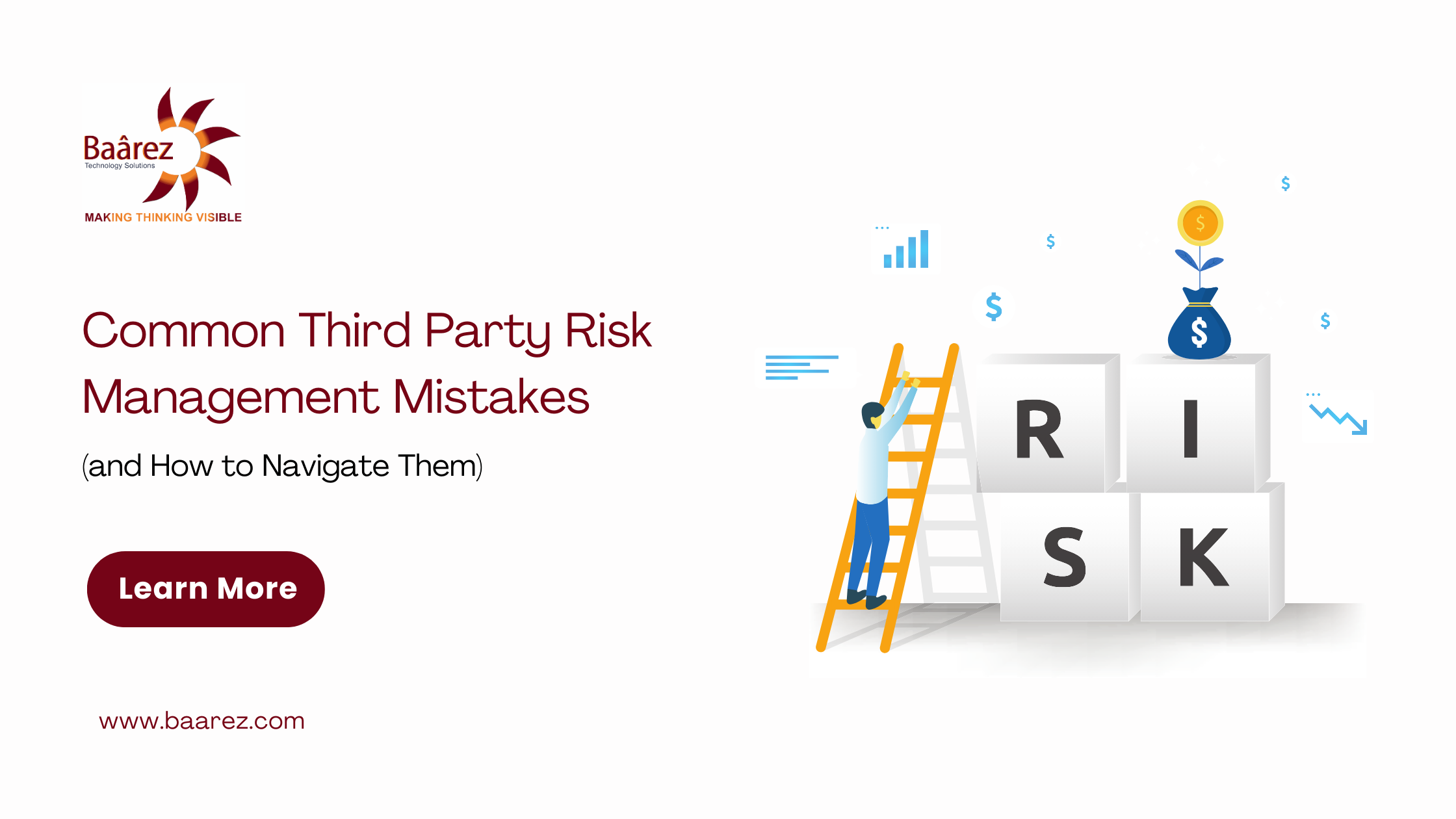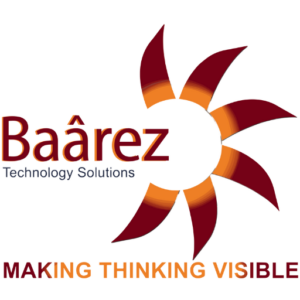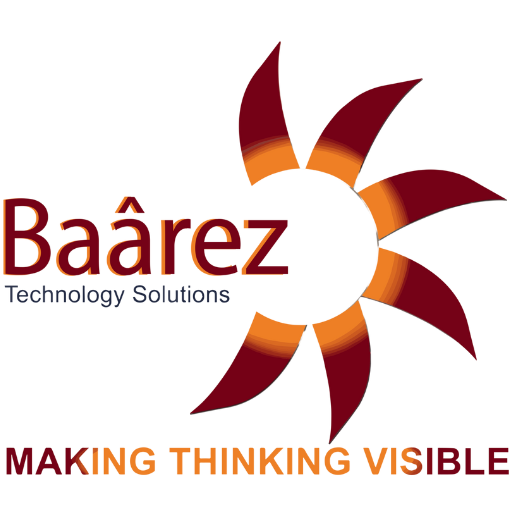
Table of Contents
ToggleEverything You Need to Know About Third-Party Risk Management
Third-Party Risk Management (TPRM) involves identifying, assessing, and mitigating risks associated with outsourcing to external parties. For companies like Baarez Technology Solutions, leveraging AI-powered solutions can streamline these processes, enhancing efficiency and accuracy in managing third-party risks.
What is Third-Party Risk Management?
Third-Party Risk Management (TPRM) is the practice of evaluating and managing the risks that arise when businesses engage with external vendors or service providers. This involves continuous monitoring and assessment to ensure these third parties do not negatively impact the organization’s operations, reputation, or compliance status.
Read more about How Third Party Risk Management Software Can Save Your Business From Disaster
Common Mistakes of Third-Party Risk Management
Organizations often overlook critical aspects of TPRM, such as failing to conduct thorough due diligence, neglecting continuous monitoring, or not setting clear expectations with vendors. Baarez Technology Solutions’ AI-powered TPRM solutions can help mitigate these mistakes by providing comprehensive risk assessments and real-time monitoring.
What You Should Know About Modern TPRM
You Must Understand the Technical Footprint
Understanding the technical footprint of your third-party vendors is crucial. This involves knowing the IT infrastructure and data management practices they employ. Baarez Technology Solutions’ AI-driven analytics can provide detailed insights into the technical setups of your vendors, helping you identify potential vulnerabilities.
Focus on What Matters Most to Your Organization
Effective TPRM requires focusing on the risks that pose the greatest threat to your organization. Baarez Technology Solutions’ AI tools prioritize risks based on your specific business context, ensuring that you allocate resources to the most critical areas.
Set and Convey Your Standards to Tiered Vendors
Clear communication of standards and expectations to all third-party vendors is essential. Baarez Technology Solutions helps automate this process, ensuring that all vendors understand and adhere to your compliance and security requirements.
Understand Your Ecosystem
A thorough understanding of your entire third-party ecosystem, including how different vendors interact with each other and your organization, is vital. Baarez Technology Solutions provides a comprehensive view of your vendor landscape, highlighting interdependencies and potential risks.
Don’t Be Afraid of Simplicity
Simplicity in TPRM processes can enhance efficiency. Baarez Technology Solutions emphasizes user-friendly, AI-powered platforms that simplify complex risk management tasks without compromising on thoroughness.
Read more about How to Calculate Risk Appetite for Third-Party Risk Management
Why Is Third-Party Risk Management Important?
TPRM is crucial because third-party vendors can introduce significant risks, including data breaches, regulatory non-compliance, and operational disruptions. Effective TPRM, powered by solutions like those from Baarez Technology Solutions, helps protect your organization from these potential threats.
What Is a Third-Party Risk Assessment?
A third-party risk assessment involves evaluating the risks associated with a third-party vendor before and during the engagement. Baarez Technology Solutions uses AI to streamline this assessment process, providing accurate and timely risk evaluations.
Read more about Understanding the 5 Phases of Third-Party Risk Management
What Is the Difference Between Vendors and Third Parties?
Vendors are suppliers of products or services, while third parties can include any external entity, such as partners, contractors, or affiliates. Baarez Technology Solutions offers TPRM solutions that cover a broad range of third-party relationships, ensuring comprehensive risk management.
What Is a Third Party in Business?
In business, a third party is any external organization or individual that interacts with your company. This can include suppliers, contractors, and partners. Baarez Technology Solutions’ AI-powered TPRM solutions help manage and mitigate risks associated with these diverse third-party relationships.
How Do You Manage Third-Party Vendors?
Managing third-party vendors involves continuous monitoring, assessing compliance with contractual obligations, and evaluating performance. Baarez Technology Solutions provides tools that automate these processes, making vendor management more efficient and effective.
Read more about Why is Third-Party Risk Management Important?
What Is a Third-Party Insurance Policy?
A third-party insurance policy provides coverage for claims made by external entities against your organization. Baarez Technology Solutions integrates risk management practices that ensure your vendors meet insurance requirements, safeguarding your organization.
Managing and Mitigating Third-Party Risk
Effective TPRM involves both managing and mitigating risks. This includes identifying potential risks, implementing controls, and continuously monitoring vendor performance. Baarez Technology Solutions’ AI-driven platform supports these activities, enhancing your risk management capabilities.
Improve Your Third-Party Risk Management Program with Risk Cloud
Baarez Technology Solutions offers Risk Cloud, an AI-powered platform that enhances your TPRM program by providing advanced analytics, real-time monitoring, and streamlined risk assessment processes. Risk Cloud helps you stay ahead of potential risks, ensuring a robust third-party risk management strategy.
Frequently Asked Questions
-
1. What are the 5 phases of third party risk management?
The five phases of third party risk management are:
- Identification: Recognizing and cataloging third-party relationships and associated risks.
- Assessment: Evaluating the potential risks posed by third parties.
- Mitigation: Implementing measures to reduce identified risks.
- Monitoring: Continuously overseeing third-party activities and risk levels.
- Termination: Properly ending third-party relationships when they are no longer needed or pose unacceptable risks.
-
2. What are the roles and responsibilities of third party risk management?
Roles and responsibilities in third party risk management typically include:
- Risk Management Team: Oversees the TPRM program, conducts risk assessments, and ensures compliance with policies.
- Business Units: Engage third parties, ensure their compliance with contractual obligations, and report on their performance.
- Procurement: Manages the selection and contracting process, ensuring third-party compliance with risk management standards.
- Legal Department: Reviews and drafts contracts to include risk management clauses.
- IT and Cybersecurity: Evaluates and monitors third-party cybersecurity risks.
- Compliance and Audit: Ensures third parties adhere to regulatory and internal policies.
-
3. How to manage third party risk?
Managing third party risk involves several steps:
- Due Diligence: Conduct thorough background checks and risk assessments before engaging third parties.
- Contractual Safeguards: Include risk management clauses in contracts, such as audit rights and compliance requirements.
- Continuous Monitoring: Regularly review third-party performance and compliance.
- Risk Mitigation Plans: Develop and implement strategies to address identified risks.
- Incident Response: Establish protocols for responding to and managing incidents involving third parties.
-
4. What is the lifecycle of TPRM?
The lifecycle of Third Party Risk Management includes the following stages:
- Planning: Identifying the need for a third party and defining the scope of the relationship.
- Due Diligence: Conducting background checks and risk assessments.
- Onboarding: Integrating the third party into the organization’s operations.
- Monitoring: Ongoing assessment of third-party performance and risk.
- Termination: Ending the relationship in a controlled manner, ensuring all risks are mitigated.
-
5. What is the TPRM life cycle?
The TPRM life cycle is another term for the lifecycle of Third Party Risk Management, which involves:
- Planning
- Due Diligence
- Onboarding
- Monitoring
- Termination
-
6. What is the goal of TPRM?
The primary goal of Third Party Risk Management (TPRM) is to protect the organization from risks posed by third parties, ensuring that these risks are identified, assessed, mitigated, and managed throughout the lifecycle of the third-party relationship. This includes safeguarding the organization’s data, compliance with regulatory requirements, and maintaining operational resilience.
-
7. How to manage third parties?
Managing third parties effectively includes:
- Selecting Reputable Partners: Choose third parties with a strong track record and solid reputation.
- Clearly Defined Contracts: Ensure all agreements outline expectations, deliverables, and risk management requirements.
- Regular Communication: Maintain open lines of communication to address issues promptly.
- Performance Monitoring: Continuously evaluate the third party’s performance against agreed metrics.
- Periodic Reviews: Regularly reassess the relationship to ensure it continues to meet organizational needs.
-
8. Who is responsible for the third party lifecycle process?
Responsibility for the third-party lifecycle process typically falls to several stakeholders within the organization:
- Risk Management Team: Overall responsibility for the TPRM framework and processes.
- Business Units: Managing the day-to-day relationship with third parties.
- Procurement: Handling the selection and contracting process.
- Legal Department: Ensuring contracts include necessary risk management clauses.
- IT and Cybersecurity: Monitoring technological and cybersecurity risks.
- Compliance and Audit: Verifying adherence to regulatory and policy requirements.


